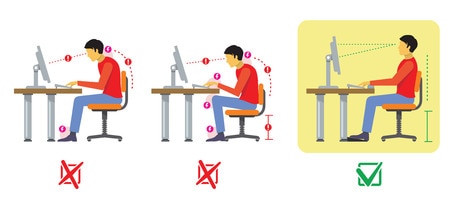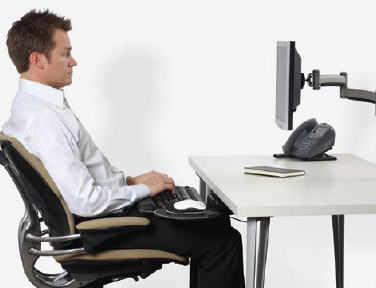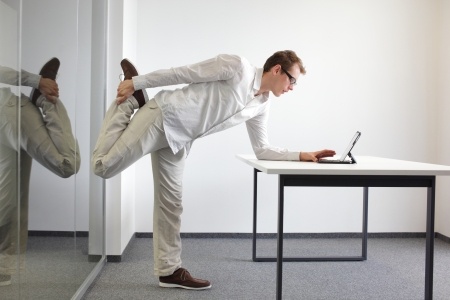Can massage therapy be a solution to poor desk posture? Let’s explore the benefits of massage therapy in combating poor desk posture.
Technology is everywhere. Whether sitting at your desk working on a computer, checking the number of likes on your most recent Facebook post from your smartphone, or just talking to your mom, technology has infiltrated every aspect of our lives, and odds are your body is suffering because of it.
There are a myriad of problems that can arise from poor desk posture and smartphone use:
1. Hunched shoulders and forward head positioning

Sitting for long hours at a desk causes our shoulders to roll forward, shortening our pectoral muscles in front while overstretching and fatiguing our trapezius and rhomboid muscles on our back. Once the much stronger pectoral muscles have shortened, the weakened trapezius and rhomboids can’t hope to balance out the tension, leaving you trapped in a forward shoulder or pronated position. As the shoulders roll forward, the head also leans closer to the computer screen, shortening the muscles in the front of your neck, the SternoCleidoMastoid (SCM), and the Scalenes. For every inch the head moves forward, it adds roughly another 10 lbs of weight to your already compromised muscles. You may not have been aware of all the muscles in play, but I suspect we all know EXACTLY how it feels, and it doesn’t feel good!
2. Carpal Tunnel Syndrome
As the wrists rest on the desk, the weight of the arm puts pressure on the delicate ecosystem of the wrist. The repetitive motions of typing and mousing combined with the weight of your arms can cause the tendons moving through the wrist to become inflamed and irritated. This can cause pain, weakness, tingling, and a loss of sensation, among other things.
3. Lower back pain
Our bodies are designed to be dynamic and expressive. Our contemporary work culture places unnatural demands for us to sit in one place for hours. Sitting for long periods of time can wreak havoc on our wonderful spines! The muscles surrounding our lumbar spine become tight and unresponsive from under use. Our abs become weak, and our hip flexors become shortened, much like our pectoral muscles do. This combination of imbalanced muscles can lead to a number of possible injuries and limit our ability to move fully and enjoy our daily lives.
For other causes (and possible treatments) of lower back pain, check out our online virtual event, ‘Low Back Pain: Common Causes and Treatments.’
Avoiding Injury from Bad Desk Posture
The good news is that massage therapy can soften and lengthen the stiff, shortened tissues, reduce the inflammation in both muscles and tendons, and improve overall circulation, all while reducing pain and increasing relaxation. A good massage therapist will know how to address each region while customizing a treatment plan to fit your individual needs.
Tips to prevent problems:
1. Make sure your monitor is nice and high.
Optimally, you want to be seated just like when you are driving, leaning slightly back and looking directly forward. If you use a laptop, try and find a separate monitor that you can place in your line of vision so as to avoid looking down at your screen.
2. Put your keyboard in your lap.
This keeps the shoulders in a natural, neutral position, keeping extra weight out of the neck and reducing the strain on the front of the wrists. Using a full size keyboard will help reduce the compression in the wrists as well.
3. MAKE SURE YOU STRETCH!
Get up every 20-30 minutes and stretch out, even if it’s only for one or two minutes. This will increase blood flow and help keep muscles supple and mobile. If you feel yourself getting stiff, be proactive with your health and move around a bit. Check out some stretches and exercises here.
While massage therapy isn’t a silver bullet, it can be very effective in reducing pain and stiffness associated with working at a computer, desk, or smartphone. Want to give massage therapy a try? Give us a call or fill out the form below to start combating your poor desk posture.




